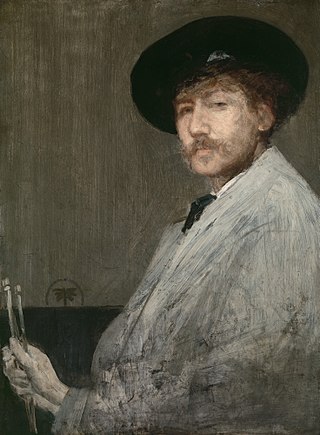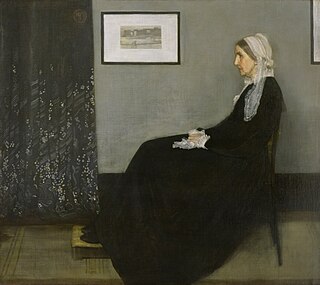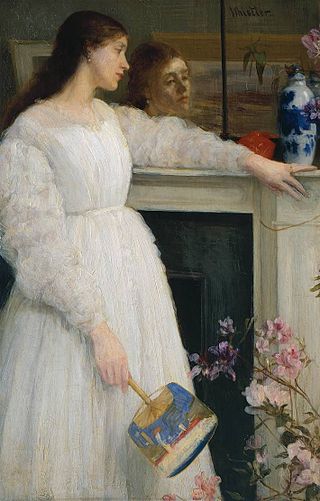
Impressionism was a 19th-century art movement characterized by relatively small, thin, yet visible brush strokes, open composition, emphasis on accurate depiction of light in its changing qualities, ordinary subject matter, unusual visual angles, and inclusion of movement as a crucial element of human perception and experience. Impressionism originated with a group of Paris-based artists whose independent exhibitions brought them to prominence during the 1870s and 1880s.

Edgar Degas was a French Impressionist artist famous for his pastel drawings and oil paintings.

James Abbott McNeill Whistler was an American painter in oils and watercolor, and printmaker, active during the American Gilded Age and based primarily in the United Kingdom. He eschewed sentimentality and moral allusion in painting and was a leading proponent of the credo "art for art's sake".

The Salon des Refusés, French for "exhibition of rejects", is generally known as an exhibition of works rejected by the jury of the official Paris Salon, but the term is most famously used to refer to the Salon des Refusés of 1863.

Walter Richard Sickert was a Bavarian-born British painter and printmaker who was a member of the Camden Town Group of Post-Impressionist artists in early 20th-century London. He was an important influence on distinctively British styles of avant-garde art in the mid and late 20th century.

Arrangement in Grey and Black No. 1, best known under its colloquial name Whistler's Mother or Portrait of Artist's Mother, is a painting in oils on canvas created by the American-born painter James McNeill Whistler in 1871. The subject of the painting is Whistler's mother, Anna McNeill Whistler. The painting is 56.81 by 63.94 inches, displayed in a frame of Whistler's own design. It is held by the Musée d'Orsay in Paris, having been bought by the French state in 1891. It is one of the most famous works by an American artist outside the United States. It has been variously described as an American icon and a Victorian Mona Lisa.

Japonisme is a French term that refers to the popularity and influence of Japanese art and design among a number of Western European artists in the nineteenth century following the forced reopening of foreign trade with Japan in 1858. Japonisme was first described by French art critic and collector Philippe Burty in 1872.

The Gentle Art of Making Enemies is a book by the painter James McNeill Whistler, published in London in 1890 by William Heinemann, who also published a second, enlarged edition in 1892. The book was in part a response to, in part a transcript of, Whistler's famous libel suit against critic John Ruskin. Ruskin, in a review of the inaugural showing at the Grosvenor Gallery, had referred to Whistler's painting Nocturne in Black and Gold – The Falling Rocket as "flinging a pot of paint in the public's face". The book contains Whistler's letters to newspapers chronicling his many petty grievances against various acquaintances and friends, and it contains his famous 1885 lecture, "Ten O'Clock", explaining "the meaning and purpose of art".

Philip Wilson Steer was a British painter of landscapes, seascapes plus portraits and figure studies. He was also an influential art teacher. His sea and landscape paintings made him a leading figure in the Impressionist movement in Britain but in time he turned to a more traditional English style, clearly influenced by both John Constable and J. M. W. Turner, and spent more time painting in the countryside rather than on the coast. As a painting tutor at the Slade School of Art for many years he influenced generations of young artists.

William Stott (1857–1900) was a painter born in Oldham, Lancashire, England.

The Bellelli Family, also known as Family Portrait, is an oil painting on canvas by Edgar Degas (1834–1917), painted c. 1858–1867, and housed in the Musée d'Orsay. A masterwork of Degas' youth, the painting is a portrait of his aunt, her husband, and their two young daughters.

Joanna Hiffernan or Joanna Heffernan was an Irish artists' model and muse who was romantically linked with American painter James Abbott McNeill Whistler and French painter Gustave Courbet. In addition to being an artists' model, Hiffernan herself also drew and painted, although it is not believed she ever exhibited her work.

In art, a 'nocturne' its broader sense distinguishes paintings of a night scene, or night-piece, such as Rembrandt's The Night Watch, or the German Romantic Caspar David Friedrich's Two Men Contemplating the Moon of 1819.

Rosa Frances Corder was a Victorian artist and artist's model. She was the lover of Charles Augustus Howell, who is alleged to have persuaded her to create forgeries of drawings by Dante Gabriel Rossetti.

Symphony in White, No. 1, also known as The White Girl, is a painting by James McNeill Whistler. The work shows a woman in full figure standing on a dog skin in front of a beige curtain with a lily in her hand. The colour scheme of the painting is almost entirely white. The model is Joanna Hiffernan, the artist's mistress. Though the painting was originally called The White Girl, Whistler later started calling it Symphony in White, No. 1. By referring to his work in such abstract terms, he intended to emphasize his "art for art's sake" philosophy.

Symphony in White, No. 2, also known as The Little White Girl is a painting by James McNeill Whistler. The work shows a woman in three-quarter figure standing by a fireplace with a mirror over it. She is holding a fan in her hand, and wearing a white dress. The model is Joanna Hiffernan, the artist's mistress. Though the painting was originally called The Little White Girl, Whistler later started calling it Symphony in White, No. 2. By referring to his work in such abstract terms, he intended to emphasize his "art for art's sake" philosophy. In this painting, Heffernan wears a ring on her ring finger, even though the two were not married. By this religious imagery, Whistler emphasizes the aesthetic philosophy behind his work.

Interior, also known as The Rape, is an oil painting on canvas by Edgar Degas (1834–1917), painted in 1868–1869. Described as "the most puzzling of Degas's major works", it depicts a tense confrontation by lamplight between a man and a partially undressed woman. The theatrical character of the scene has led art historians to seek a literary source for the composition, but none of the sources proposed has met with universal acceptance. Even the painting's title is uncertain; acquaintances of the artist referred to it either as Le Viol or Intérieur, and it was under the latter title that Degas exhibited it for the first time in 1905. The painting is housed in the Philadelphia Museum of Art.

Mother of Pearl and Silver: The Andalusian is a painting by James McNeill Whistler. The work shows a woman in full figure standing with her back to the viewer, with her head in profile. The model is Ethel Whibley, the artist's secretary and sister-in-law.

Lady in White is an impressionist painting of a woman wearing a white robe, from 1886, by Dutch painter Jan Toorop.

Beatrice Whistler was born in Chelsea, London on 12 May 1857. She was the eldest daughter of ten children of the sculptor John Birnie Philip and Frances Black. She studied art in her father's studio and with Edward William Godwin who was an architect-designer. On 4 January 1876 she became the second wife of Edward Godwin. Following the death of Godwin, Beatrice married James McNeill Whistler on 11 August 1888.




















